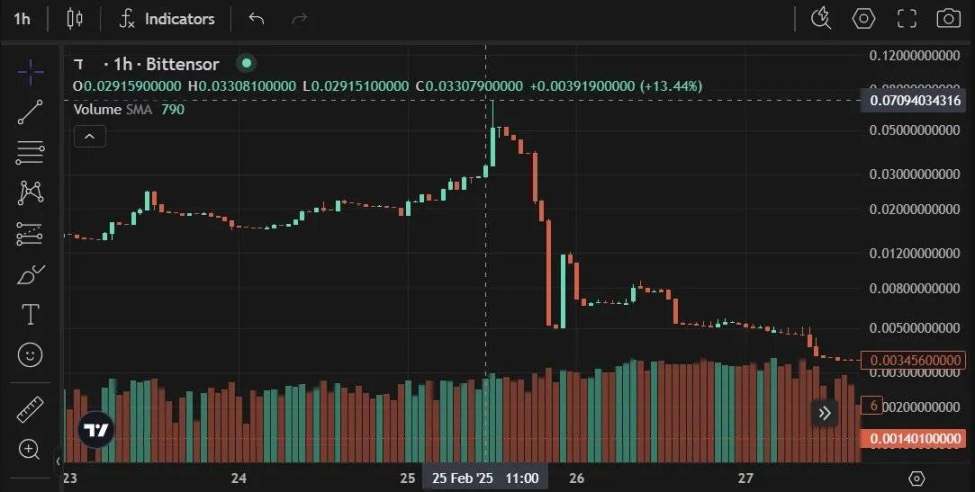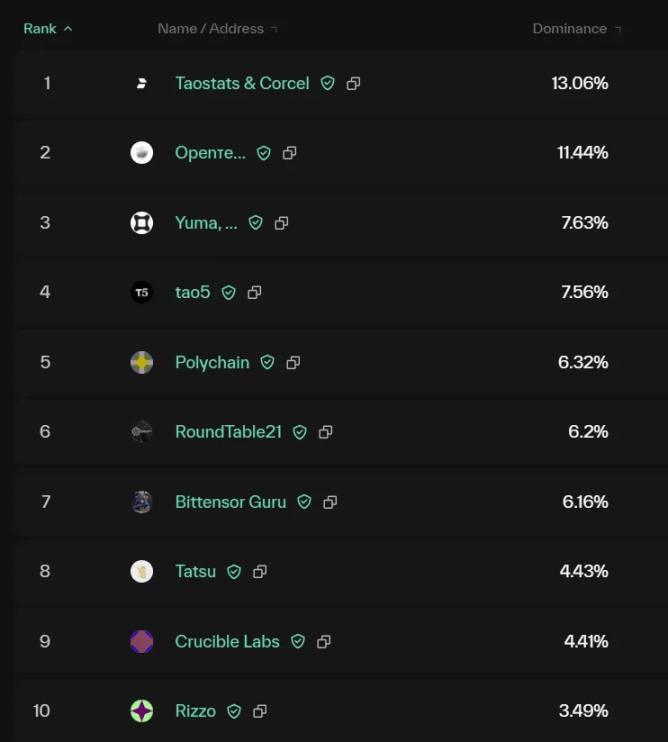dTAO is on the line for a month: Meme-filled subnets, broken token economics

Reprinted from panewslab
03/21/2025·2MAuthor: donn
Compiled by: Deep Tide TechFlow
I'm always interested in novel tokenomics. It’s always fascinating to observe how crypto protocols adjust incentives, and sometimes they look very tempting – until inevitably crashing. So, when Bittensor launched its dynamic $TAO (dTAO) system on Valentine's Day, I was immediately attracted.
The idea is simple: to provide a new and more "equitable" way of distribution between subnets for TAO distribution.
But just one month later, the problem emerged. It turns out that seemingly perfect designs don't always work as they wish in the free market.
dTAO operation mechanism
Here is a simplified review of how dTAO works:
Each subnet has its own subnet token ($SN), which exists in the form of a native TAO-SN UniV2 type pool. Confusingly, although the user "stakes" TAO in exchange for SN, this is actually no different from "redeeming" TAO as SN. The only difference is that users cannot add liquidity to the liquidity pool, nor can they directly trade between subnet tokens (e.g. SN1 → SN2), but can be used as an intermediary through TAO (SN1 → TAO → SN2).
The TAO issuance is distributed proportionally based on the price of the subnet SN tokens. To smooth price fluctuations or prevent price manipulation, the system uses moving average prices.
The SN token itself also has a high issuance volume, with a supply cap of 21 million, similar to TAO and BTC. A portion of the SN is assigned to the TAO-SN liquidity pool, while the rest is assigned to the stakeholders of the subnet (miners, validators, subnet owners). The number of SNs allocated to the TAO-SN pool is to balance the issuance of TAOs in the pool, so that the price of SNs (in TAOs) remains stable while increasing liquidity.
However, if the above calculation results indicate that the number of SNs required by the subnet exceeds the maximum issuance of SN (the issuance curve based on the SN), the issuance of SN will be limited to the maximum value, and the price of SN (in TAO) will rise.
The core assumption of this mechanism is that subnets with higher market capitalization create more value for the Bittensor network, so they should receive more TAO circulation.
However, the reality is that the most expensive tokens in the crypto market are often those with the most attention, hype, Ponzi characteristics and marketing resources. This is why L1 public chains and memecoins always have relatively highest valuations.
Although the starting point of mechanism design is good, assuming that subnets that generate value through revenue will repurchase SN tokens with part of their revenue, thereby pushing up prices and obtaining more TAO circulation, this idea is a bit naive.
Subnets filled with Meme coins and out-of-control token economics
Before dTAO started, I discussed with some crypto analysts the obvious flaw in dTAO token economics—that is, higher market cap ≠ higher income or greater value creation.
But I didn't expect that this theory will be verified in practice soon. The free market operates in a "wonderful" way.
Just before the upgrade, an anonymous person took over subnet 281 and turned it into a meme coin subnet called "TAO Accumulation Corporation" ("LOL Subnet" for short). This obviously has nothing to do with AI.
In the now deleted Github page, it says:
The miner does not need to run any code, and the validator scores it based on the number of subnet tokens held by the miner. The more tokens the miner holds, the higher the issuance volume obtained.
What actually happens is: Speculators buy SN28 tokens → SN28 price rises → SN28 gets more TAO issuance → If the issuance limit of subnet tokens is exceeded, the SN28 price continues to rise → The issuance of SN tokens is distributed proportionally to the "miners" holding SN → People buy more SN to get more TAO → Price rises further → Ponzi cycle continues.
As a result, TAO's circulation officially started funding... Memes! At some point, the SN28 subnet even became the seventh-ranked subnet with market value.
But why did SN28 fail to occupy Bittensor? Centralization saves the situation
In just a few days, the Opentensor Foundation used its root stake to run customized validator codes, inspiring people to sell SN28 tokens, causing its price to plummet 98% in a few hours.

Source: Bittensor discord

SN28 subnet tokens plummeted 98% after the Opentensor Foundation's action
Essentially, the Opentensor Foundation plays the role of a centralized entity, preventing the use of the dTAO mechanism by the free market. This centralized intervention is currently feasible because it is currently in a slow transition period from the old TAO issuance mechanism to the new dTAO mechanism.
Transition from TAO's legacy mechanism to dTAO
The old TAO mechanism allows 64 validators who pledge the maximum TAO on SN0 ("root subnet") to vote to decide who can obtain the TAO's issuance.
This mechanism itself raises a series of incentive problems caused by the control of power by large validators (such as the Opentensor Foundation, DCG Yuma, Dao5, Polychain, etc.). For example, they could theoretically direct the TAO's circulation to the subnets they invested in or incubated, or to the subnets they run validator nodes and receive TAO rewards from them.

Top validators shown in taostats.io/validators
Therefore, getting rid of this mechanism is a good step towards decentralization. I appreciate the team's choice of a more decentralized reward mechanism, even if it means they may lose some of their circulation.
When the SN28 incident occurred, dTAO had just been launched for about a week, so SN0 (the blue line in the picture below) still controlled about 95% of the circulation, and the Opentensor Foundation was able to intervene.
However, after about a year, SN0's control over the issuance will drop to about 20%. This means that if an SN28-like event occurs again, it is almost impossible to intervene through SN0. In this case, Bittensor may go from a "decentralized AI" project to an incentivized network for meme coins.

During this transition period, the power to control emissions will be transferred from the old mechanism (SN0 or "root attribute") to the new dTAO mechanism ("alpha attribute")
Admit it, it's not just meme
Even if we assume that people are rational enough in a bear market and do not dive into meme coin speculation, Bittensor may still evolve into a universal incentive network that is completely unrelated to AI.
Imagine a thought experiment: Someone launched a subnet dedicated to decentralized mining of Bitcoin (although this is not a novel idea). The goal of this subnet is to incentivize Bitcoin mining through resource-efficient means, and at the same time use the mined BTC as recurring revenue to repurchase subnet token SN to obtain more TAO issuance.
Therefore, TAO has changed from a decentralized AI project to a general incentive project, and the issuance of TAO is only used to subsidize various random operating costs (OpEx) of the enterprise, rather than moving towards a specific goal.
Technically, this can be said to be in line with the original intention of the Yuma consensus mechanism, because the Yuma consensus aims to reach a consensus around any "subjective" work, not necessarily limited to AI. However, this lack of clear goals makes the entire system seem… meaningless.
The final thought
The dTAO model was launched just one month ago and the cracks have emerged.
The incentive mechanism of the free market shows that without any centralized power, Bittensor may no longer be an AI project, but a "attention network" dominated by the meme coin subnet, or a "general incentive network" dominated by revenue-generating companies that use TAO issuance to subsidize operating costs without substantially improving the Bittensor network.
I think the network needs a real "objective function" to unify the goals of all subnets. However, it is obvious that finding a clear goal in the field of AI (especially general artificial intelligence, AGI) is very difficult—as the challenges we encounter when running a fair large language model (LLM) evaluation framework… This is why the Yuma consensus was created for "subjective" work.
As the famous saying goes, “Tell me the incentive mechanism, and I will tell you the results.”
In previous versions, I mentioned that the circulation of TAO is proportional to market value, but is actually proportional to price. This error has now been corrected, thanks to @nick_hotz for correcting it.

